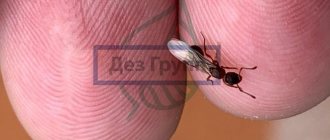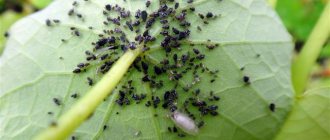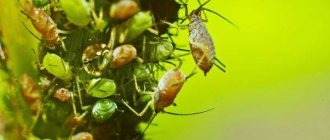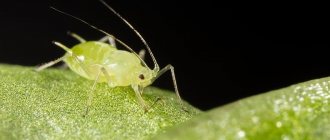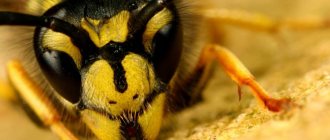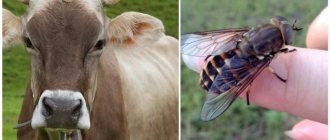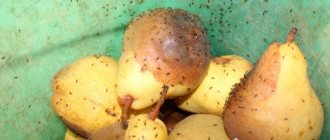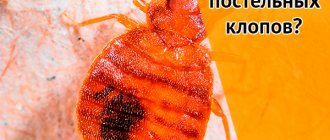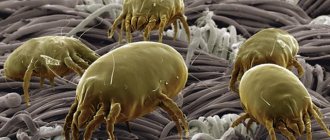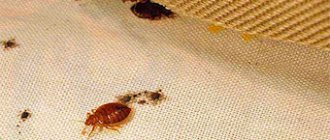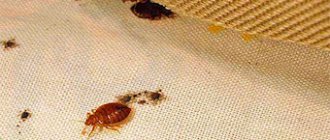Causes of pests on orchids
Insects can appear on plants for several reasons:
- Contaminated soil. If the soil mixture was prepared incorrectly and was not disinfected before use, eggs or larvae could remain in it. If you transplant an orchid into it and then water it, conditions favorable for the development of pests will be created. The midges will begin to actively reproduce.
- Excessive watering. Midges can enter a house through a window, but unless they find suitable conditions, they will not stay indoors. If there are plants inside with constantly moist soil, insects will take up residence there.
Insects leave noticeable damage on orchid leaves
- Using moss. As a rule, gardeners use it to slow down the evaporation of moisture from the soil. If parts that have begun to decompose are not promptly removed, pests appear.
- The use of natural fertilizers: shells, tea leaves, coffee grounds. Decaying organic matter attracts insects.
Important! To choose the right remedy for midges on plants, you need to identify and eliminate the cause of their appearance.
What kind of midges live in orchids?
Contents of the article:
- 1 What kind of midges live in orchids? 1.1 Midges in orchids. What should I do?
- 1.2 Fungus gnat in an orchid
- 1.3 Thrips in orchids
- 7.1 Where do midges come from in orchids?
- 8.1 Method - how to get rid of insects
- 10.1 Types of midges in orchids
Midges in orchids. What should I do?
If you notice that midges are flying around a pot with an orchid, then you may have questions:
- What kind of midges live in orchids?
- Are midges dangerous in orchids?
- What needs to be done and how to get rid of midges in orchids?
- Today's article is dedicated to answering these questions.
Midges that infest orchids can be “harmless” fungus gnats or “harmful” thrips. In order to choose the right means of protection, it is necessary to identify the flying insect.
First, analyze your watering regime and make sure that you do not overwater the orchid and leave two or three dry days between waterings. In this case, dry days are considered not those days when the soil dries out on the surface of the pot, but those days when the soil dries out completely throughout the entire depth of the pot.
https://youtube.com/watch?v=GySTAsWgLpQ%3Ffeature%3Doembed
For more information on how to determine whether the soil in a pot with an orchid is dry, read the article “How often to water an orchid.” Next, evaluate whether there is damage to the orchid leaves: multiple dark spots or a silvery film.
Fungus gnat in an orchid
If you water the orchid frequently and do not leave two or three dry days between waterings, and there are no characteristic damages on the leaves (multiple dark spots or a silvery film), then in your case, most likely, a fungus gnat has appeared in the orchid.
To finally make sure of this, evaluate the habitats and appearance of the midges.
Where do they live? Fungus gnats live in the ground. If we talk about orchids, then, as a rule, fungus gnats settle in those pots in which the soil consists not only of bark, to which moss or peat is added.
Important! Mosquitoes live in clean bark only if the bark has already decomposed. In particular, fungus gnats came to our house and lived in plants that grow in the soil, but they were not interested in orchids that grow in the bark. Appearance? Adults look like small black mosquitoes; in fact, they are most often represented when people talk about “midges.”
Appearance? Adults look like small black mosquitoes; in fact, they are most often represented when people talk about “midges.”
Are they dangerous? Adult fungus gnats do not cause harm. Damage can be caused by larvae, which in large numbers can damage the roots.
How to treat? The main method of protection is drying: in dry soil the larvae will not hatch, and the adults live for two weeks. Start by reducing watering of the orchid. Additionally, you can buy yellow sticky tape at the flower shop to collect the adults.
Or put a yellow saucer with water - mosquitoes fly towards the yellow color. As a last resort, you can replace the soil by washing the orchid roots to remove mosquito larvae. And in the future, follow the general rules for watering orchids.
Thrips in orchids
Thrips in orchids If you notice that multiple bites have appeared on the leaves, which on the green leaf of the orchid become white, silver, and darken over time, then there is a high probability that your orchid is being devoured by thrips.
Where do they live? Thrips, unlike mosquitoes that live in the ground, live on leaves and actively feed on orchid leaves.
Appearance? They have an elongated shape, a striped abdomen and two wings.
Thrips, rather, do not even fly, but quickly run and hide in the bark. Multiple damage appears on the leaves - bite sites,
Are they dangerous? Thrips, unlike fungus gnats, cause significant harm to the orchid. Insects pierce plant cells and completely suck out the juice from them. Fungi may grow in the bite areas.
The orchid leaf itself receives not only and not so much a decorative defect, but dies, deprived of cell sap. Therefore, if thrips are found on an orchid, you should not delay their destruction.
How to treat? For treatment, it is necessary to rinse the orchid in the shower (during the next watering), which will wash off some of the individuals, and treat the orchid with Fitoverm (or another drug for thrips) according to the instructions at least 3 times with an interval of 10 days.
Types of midges
Midges in indoor flowers - how to get rid of them at home
You can understand how to get rid of midges in orchids only by first determining their type. It is important to choose an effective remedy that will not harm the plant. Most often, 4 types of insects live in flowers.
Thrips
Small - up to 2.5 mm - dark-colored midges with an elongated body and wings folded on the back. It is not easy to detect them, since they are active in the dark and hide in the soil in the sun. Dry soil is attractive to pests of this type, so you need to water the flower regularly.
A sign of their presence can be dark spots on the leaves. They reproduce quickly and lay eggs on leaves. Adults damage all parts of the plant, sucking out the juice, while the larvae damage only the leaves.
Whiteflies
You can learn about the appearance of white small flies by carefully examining the plant (you can see yellow marks on it) and the soil where the eggs or light-colored larvae will be located. If you touch a flower, butterflies will scatter throughout the room.
Whiteflies live on the undersides of leaves, making them difficult to detect
The larvae feed on leaf sap, so the leaves of orchids affected by whiteflies begin to dry out and turn yellow.
Sciarides
They are black mosquitoes, not exceeding 5 mm in size. They are most active in autumn or spring.
Adults (this is their second name) do not harm phalaenopsis, but lay eggs in the ground. The hatched larvae feed on the roots of the plant. The affected areas of the root system begin to rot, fungus and infections penetrate inside, due to which the orchid may die.
Drosophila
Fruit midges do not eat the plant; they feed on rotting organic matter. As a rule, they appear in groups, hovering over areas of interest to them. They pose a danger because they reproduce at high speed. If you do not remove insects, they will quickly fill the apartment.
Description of pests
Before you start fighting small flies, you should determine which insect has infested your indoor flower. Some small midges do not harm the plant, while others can destroy it. To understand this, you should know some facts about each of them.
- Fungus gnats are insects that are extremely similar to midges. They fly around the flower, are small in size and are found in the cold season. Most often, parasites appear in spring or autumn. They do not harm the orchid, but their larvae in the soil are capable of destroying the roots, which, in turn, begin to rot and die.
- Whiteflies are white midges that can live on flowers. They are 2-3 millimeters long. They are quite easy to see, as they are capable of leaving yellow streaks on the leaf blades. The larvae are found on young stems and leaves of the orchid and infect these areas, which contributes to the extinction of the plant.
- Drosophila are yellow in color and have red eyes. They are fruit midges that can lay more than four hundred eggs at a time. The larvae are active the day after laying eggs and within a week they grow into full-fledged adult insects. Pests do not cause much harm to the plant, but they greatly interfere by flying nearby.
- Thrips are elongated black insects with small stripes on their backs. Most often they inhabit the leaves of the plant, sometimes they can be found in the soil. If a grower sees a silvery film and a large number of black dots on the leaf blades, it means that he has encountered this parasite. The leaves become dry, subsequently the plant may die. It should be remembered that these insects are active only at night, but it is extremely difficult to see them during the day. Thrips can infect not only leaf blades, but also the root system. They are small, but multiply very quickly, so you should get rid of them quickly.
Midges in orchids: how to get rid of them at home
Mealybug on an orchid: how to get rid of pests and treatments
If there are midges in an orchid, what to do first:
- Place the pot with the infected plant in quarantine for a month, that is, place it separately from other flowers.
- Place the flower under a gentle stream of warm water to wash away larvae, eggs and adults.
- Inspect the soil, stems and leaves, remove any remaining eggs and larvae with a damp cloth.
- Cut off dead and damaged parts of the plant, dust the cut areas with ash or crushed coal.
To remove pests from the roots, the plant is thoroughly washed with warm water.
Important! If the soil is heavily infested with pests, it is necessary to replant the orchid, thoroughly washing the roots.
Traditional methods
What to do if midges appear in the ground in orchids:
- Treat with soapy water. 1 tbsp. l. soap (preferably without dyes and other additives) is diluted in a glass of water. Moisten a cotton pad with the composition and gently wipe all parts of the plant for a week. After a break of several days, another 2-3 treatment cycles are repeated. When the insects disappear, wait a month, after which they wipe the flower once to prevent the reappearance of midges.
- Use garlic infusion. The cleaned head is crushed, poured Art. boiling water The liquid is used in the same way as a soap solution.
- Prepare an apple cider vinegar trap. The liquid is poured into a small jar, mixed with a couple of drops of dishwashing gel, and closed with a plastic lid with small holes made in it. The prepared container is placed next to the flower pot. Midges (fruit flies and sciarids), sensing the smell, will fly inside and die, since they will not be able to get out of the trap.
- Place citrus peels or garlic cloves around the plant. This folk method is based on the fact that strong odors repel insects.
- Prepare a weak solution of potassium permanganate and pour it over the soil. The disinfectant liquid will destroy the eggs and larvae.
- Sprinkle the soil with mustard powder. Repeat the procedure once a week until all midges disappear.
Spraying with garlic infusion is a plant-safe way to remove pests
Chemicals
Getting rid of insects using potent drugs is recommended in extreme cases when other methods have not helped.
The most difficult thing to deal with are sciarids. You will need to use several products in combination: the above-ground parts of the plant are treated with “Raid”, “Raptor” or “Neo Dichlorvos”, for the soil use “Bazudin” or “Grom-2”. Pests can remain not only in the pot, but also on the surfaces around it, so you need to wipe the windowsill with a disinfectant.
Actillicom is suitable for killing thrips. The infected plant is treated with this drug three times over a period of 10 days.
“Actellik” also effectively copes with whiteflies. They are also removed using insecticides “Sherpa” or “Fury”. To get rid of eggs and larvae, the soil is spilled with water.
How to get rid of it at home using biological methods
If midges appear in orchids, you can get rid of them using home remedies:
- Vacuum cleaner. It will help collect whiteflies. When you touch the phalaenopsis, the butterflies immediately fly up, disturbed. You can take advantage of this behavioral feature of theirs. You need to turn on the device in advance and point the end of the suction tube (it is better to remove the nozzle) just above the plant. Touch the orchid and the whiteflies will fly up and be sucked in. It will not be possible to collect all the midges at once; you need to repeat the operation several times, taking breaks.
- Fly tape. A ribbon hung near an infested plant will collect most of the adults.
- River sand. It is pre-calcined in the oven and then poured in a thin layer onto the ground. Monitor the condition of the plant: after a few days all the midges should disappear, and if this does not happen, the procedure is repeated.
- Soil washing. Since the most difficult thing is to remove not the adults, but the larvae, you need to thoroughly wash the soil every 4 days.
Note! If there are fruit flies in the house and flower pot, you need to fight them differently. You should throw away the remains of moss, tea leaves and other natural fertilizers, if they were used, and reduce the frequency of watering. Inspect the room, remove all food that attracts fruit flies (fruits, vegetables).
To get rid of fruit flies, all moss from the ground must be removed
Getting rid of insect pests
If there are midges on orchids, then you need to get rid of them immediately, otherwise not only the flower will die, but also the crops growing nearby.
To understand how to deal with a pest, first determine its variety, then carry out measures common to any species. General rules:
- quarantine the flower for a month, isolating it from other plants;
- cut off the affected areas, then wipe the remaining leaves and stems with a solution of laundry soap, using a sponge, soft cloth, or rinse under a warm shower;
- remove the roots from the pot, free them from the substrate and rinse under running warm water;
- transplant into disinfected fresh substrate.
Note! When subsequently processing the above-ground part, cover the soil with film so that larvae and insects do not get into it.
No chemicals used
Not every pest can be gotten rid of using simple methods without the use of chemicals. For example, you can try to remove fruit flies and whiteflies using the simplest measures, but they will not help against thrips.
When midges appear, you need to wash each leaf every day for a week under running water to wash off the eggs and their waste products, or wipe with a solution of soap (preferably laundry soap). Thrips really don’t like the smell of citrus fruits, so you can put the zest of lime, lemon, or orange into the substrate, and rub the leaves with garlic, the phytoncides of which thrips also cannot tolerate.
The simplest ways:
- water the substrate with a pink solution of manganese;
- Sprinkle the soil with mustard powder once a week;
- every 3-4 days, sprinkle the soil with calcined river sand;
- replace the substrate, if it contains moss, tea leaves, which were used as fertilizer;
- hang adhesive tape next to the pots;
- Remove any food debris, stale vegetables and fruits from the premises.
Information! These control methods are effective if there are few insects and they have not had time to create large colonies, or if they are used as preventive measures.
Insecticides against midges
There are drugs that are effective at different stages of orchid damage, and how to use them to get rid of a specific insect is indicated in the instructions.
Insect and preparation for its destruction:
- Fungus gnat (sciarids). Treat the above-ground part (without flowers) with Raptor, Neo Dichlorvos, Raid, the soil with Grom-2, Bazudin. The surface where the pot stood is also subject to disinfection.
- Whitefly. Insecticides Aktara, Sherpa, Fury are effective when spraying stems and leaves.
- Drosophila. We remove midges with Dichlorvos, Hexachloran, Combat. Spraying should be carried out indoors, after half an hour, ventilate.
- Thrips. This pest is more difficult to control than other midges, so it is necessary to use Fitoverm and Actellik every 10 days until they are completely destroyed. Wash the substrate every 4 weeks with warm water.
Folk remedies
If there are few midges in orchids, then simple and affordable folk remedies, the effectiveness of which has been tested in practice, will help get rid of them:
- garlic infusion - pour several crushed cloves with warm water and leave for at least 5 hours, use to spray the green part and substrate;
- bury a peeled clove of garlic in the ground - pests do not like its smell;
- pollinate the surface of the substrate with ash;
- as a preventive measure and to remove small colonies, wipe the leaves and stems with a sponge (napkin) soaked in a warm solution prepared from 20 g of liquid soap and a glass of water;
- wipe the leaf blades and stems with an oil solution (40 g olive or grape oil + 0.5 l water).
Note! Use the products daily for 5-7 days, after a break of 3-4 days, repeat the course 2-3 times. After a month, carry out preventive treatment in any way.
Larvae - how to get rid of them
It is especially difficult to fight larvae that hide in the substrate. To destroy them, you need to pour hydrogen peroxide dissolved in water (1 part peroxide + 4 parts water). After watering, a slight hiss will be heard, confirming that the drug has reacted. As soon as the substrate dries out, water it again. The larvae should die after such exposure.
In sciarids, the larvae die if there is no moisture supply, so you need to stop watering for a while. If there are a lot of them, then the substrate needs to be replaced and the roots washed.
If affected by thrips, it is necessary to inspect the leaves and remove the affected ones - the female lays eggs in the pulp of the leaf. After pruning, spray the entire plant and substrate with an insecticide.
Prevention of infection
Whitefly on indoor plants - how to deal with it at home
To prevent insects from starting again, you should follow some rules:
- Sprinkle the soil purchased for indoor plants with plenty of water and then place it in the freezer for several days. During this time, the larvae, if they are present in the soil mixture, will die.
- Do not immediately place a purchased new flower in a room where others are located, but place it in a separate room. If after a month there are no pests on it, you can move it to the others. However, it is not recommended to keep the entire collection on one windowsill.
- Install mosquito nets on the windows to prevent insects from entering the house from the street.
- Keep the room where the orchid is kept clean and promptly throw away spoiled fruits and vegetables.
- New pots, before transplanting the plant into them, should be disinfected: pour boiling water over them or rinse with a manganese solution.
Further care
Once the pests are eliminated, it is important to care for the orchid properly. The most important thing is to follow the watering regime: twice a week in the warm season, once in the cold season.
Note! If the soil is still damp, there is no need to water it. The top layer of soil should be dry for at least 2 days beforehand.
It is undesirable to use food waste (for example, tea leaves) as fertilizer. These substances will not provide the plant with everything it needs, but will attract pests. If there is a need for feeding, you should use special ready-made compounds for orchids.
Dying leaves are removed before they begin to rot, becoming food for midges.
Leaves that have turned yellow and have begun to die should be removed.
Periodically, as a preventive measure, it is recommended to wipe the phalaenopsis leaves with a soap solution. It forms a coating that protects the above-ground parts of plants from being eaten by pests. You can also sprinkle the soil with ash or sand, this will prevent insects from penetrating into the soil.
Midges can destroy an orchid, so you need to get rid of them immediately. The listed methods will help cope with the problem, and preventive measures will prevent the reappearance of insects.
